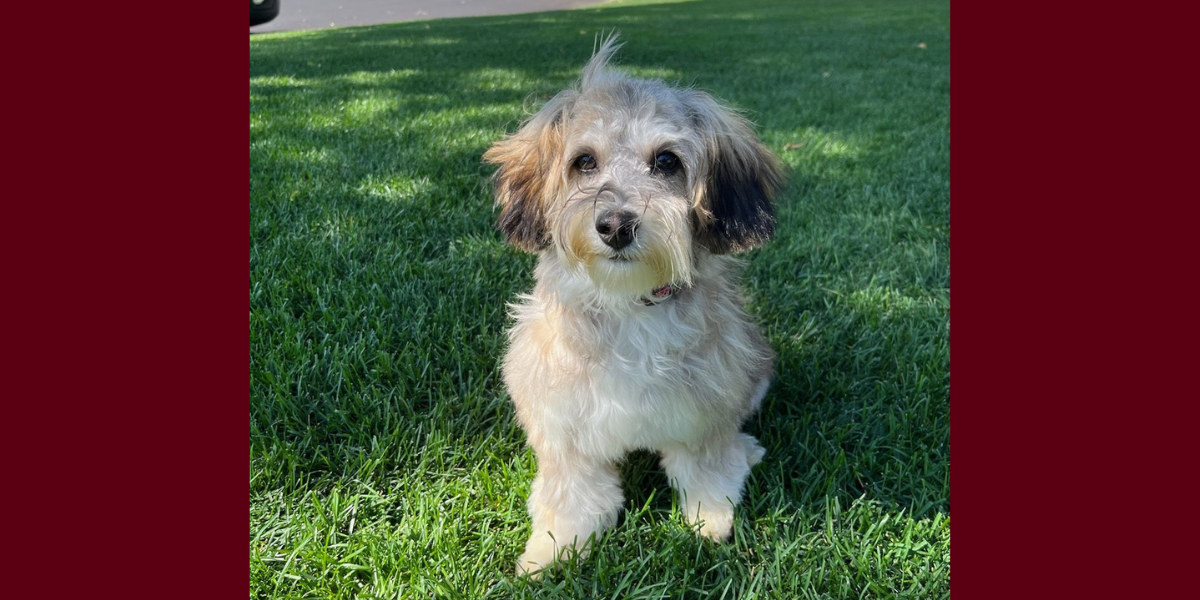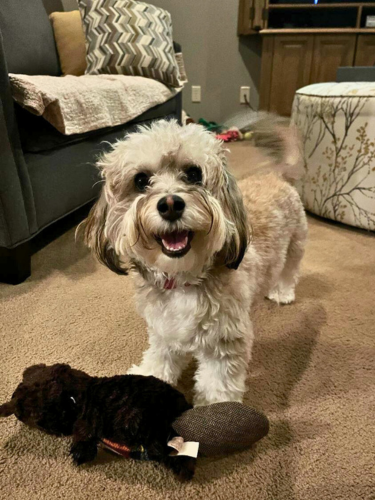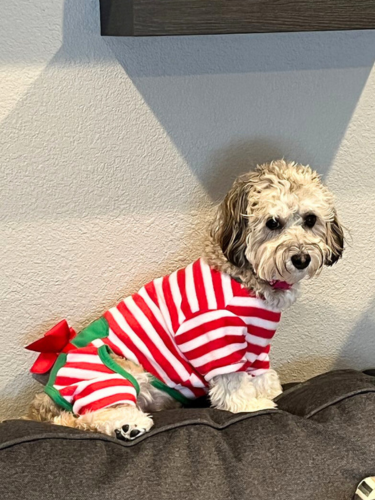Lucky Lucy
A young Havapoo escapes life in a puppy mill only to be diagnosed with a deadly cardiac condition, but expert care at the VMC gives her a second chance

A young Havapoo escapes life in a puppy mill only to be diagnosed with a deadly cardiac condition, but expert care at the VMC gives her a second chance
Lucy, an 11-month-old Havapoo, sits outside in the grass.
Things were finally looking up for Lucy. Born in an Alabama puppy mill, she had only known life in a cage. After six months of living in squalid conditions, the young Havapoo—a cross between a Havenese and a poodle—was rescued and transported thousands of miles to Apple Valley, Minn.
There, she found an adoptive family and everything seemed great—until it wasn’t. Her first veterinarian checkup brought devastating news. Lucy had a severe heart murmur, and her adopters were told she didn’t have long to live.
Crushed, they chose to surrender her back to the rescue organization. Cue Lee and Pam Kochendorfer, who were friends with Lucy’s adopters and expected that meeting the new puppy would be a happy occasion.

“When they told us her story, we couldn't see her going back to a cage if she had only a few months to live,” Pam says. “My husband and I applied to the rescue to foster Lucy in what we assumed would be a hospice situation, and we took her home with us that day.”
Lucy joined the Kochendorfer household, meeting their friendly 16-year-old Havenese named Bear and settling into a life as a spoiled foster pup. As a matter of routine, the rescue organization made a follow-up appointment to confirm Lucy’s diagnosis, this time with a cardiologist who then referred the family to the University of Minnesota Lewis Small Animal Hospital.
An exam conducted by the hospital’s Cardiology Service confirmed a diagnosis of patent ductus arteriosus (PDA), a heart defect that occurs when a blood vessel that is active during fetal development fails to close after birth. This leaves a hole between the aorta and the pulmonary artery, which results in overfilling of the left side of the heart.
“Over time, this overfilling can result in heart failure,” says Dr. Joe Herbert, a first-year resident with the Cardiology Service. “However, if we intervene and block this vessel, we prevent the overcirculation, the normal physiology can resume, and patients can often lead normal healthy lives.”
The damage from Lucy’s defect would mean she would only have a few months to live before succumbing to heart failure.
Herbert did offer some hope. Lucy could have a chance at a longer life if she underwent minimally invasive surgery to implant a medical device that would expand to fill the hole. The development of the device, known as an Amplatz Canine Duct Occluder, was led by former UMN faculty member and veterinary cardiologist Dr. Anthony Tobias.
The surgery to implant the device would be costly and rescue did not have the funds to cover it. Luck was again in Lucy’s favor as the hospital, which is part of the University’s Veterinary Medical Center (VMC), does offer financial assistance for situations such as hers. The VMC Shelter & Rescue Animal Fund helps cover the cost of specialty veterinary care for animals under the care of qualified, Minnesota-based 501(c)3 non-profit organizations. The fund is made possible by gifts from generous donors.

Lucy’s case received funding to offset costs and her surgery was soon scheduled. In September 2023, clinicians successfully implanted the occlusion device. Lucy’s recovery went smoothly and at her three-month post-surgery checkup, her heart was functioning normally and there were no longer concerns about her condition.
“Lucy’s PDA during a recheck heart ultrasound was shown to be completely occluded,” Herbert says. “As a result of the occlusion, we expect Lucy to be able to live a normal life.”
The good news was welcomed by the Kochendorfers, who are very grateful for the high-quality care that Lucy received to make this outcome possible.
“We are lucky to have such a great university right here in our own backyard teaching the next generation of veterinarians and surgeons to do great work such as developing procedures like the one Lucy had,” Pam says. “All of the staff at the Lewis Small Animal Hospital were kind, skilled, and dedicated.”
Lucy’s medical happy ending wraps into an even bigger one. The Kochendorfers have adopted her and enjoy sharing her inspiring story with anyone who meets her. It’s earned the nearly 1-year-old pup a bit of celebrity in the neighborhood. In the end, they’re happy to have brought joy to a dog whose life began in bleak circumstances.
“Lucy has a beautiful personality, she is sweet, loves people, loves other dogs and frankly is the most wonderful dog we have ever met,” Pam says. “She will stay with us and live out her life where she will get all the love and care she truly deserves.”
You can help more pets like Lucy by supporting the VMC Shelter and Rescue Animal Fund with a donation of any amount today.
Philanthropy also is crucial to expanding access to cutting-edge procedures and equipment. Make a gift to the VMC Cardiology Service Fund to support bringing life-saving care to pets.